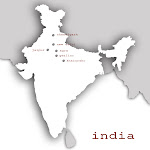









The destination today was Gwalior to see the Gwalior Fort and other Hindu Temples in the area.
Gwalior Fort was an impressive example of ornate architecture and early technologies. It boasts having the first ancient telephone. From an upper room there were tubes carved into the stone wall that traveled three stories below to the indoor swimming pool. So the King and one of his many Queens could have a conversation as they lounged around. Another interesting feature was the room that had eight columns arranged in a circle. Attached at each column were metal rings that allowed for swings to be attached and the eight Queens could swing while the King sat in the middle admiring them. The twist to the story is that when the Fort was taken over by the son of the King who built the Taj Mahal he turned the swing room into a torture and death chamber. The same rings that once held the ropes of the swings now were used to secure his prisoners. In this room he also executed his younger brother. When an invading King was approaching the Fort and the take over was eminent all of the queens gathered at the pool, which had been drained, and made a fire and jumped into it. They would rather die than be captured and become the servants of the invading king. It is amazing how the story of the architecture and events surrounding it changes it significance, etc…
Next we visited the Saas-Bahu Temple complex, which consists of two temples. The first thing that I noticed was the intricate carvings of figures that seemed to engulf the facades and interiors of the structures. These figures give away the fact that the temples are Hindu, because Muslim structures are void of figures and only contain ornamental designs and abstract symbols. As I moved through the architecture I was overwhelmed by the amount of images; making it almost impossible to process. I decided to try a different media for the sketches of this place. I found a nice place on one of the temples and began the process of capturing the essence of this place. It was so peaceful and relaxing sitting there letting the graphite scratch out the image.
The Teli-ka-Mandir is such a dominate structure; towering overhead. Its presence I’m sure was felt by all in the city below. For its overall size, the inner temple is relatively small. There were remnants of what it was like when it was in full use. I am sure it was even more impressive than it is now. Surrounding the temple is a square pediment. The temple itself has the general plan of an equal sided cross; of course with all the ornamentation and stepping it appears more intricate. The forms appear to be cascading to the ground as the building reaches toward the heavens.
Equally impressive are the carvings at the base of the hill. Giant figures chiseled out of stone; ever making their presence known to all that pass by.


The picture taken at night is breathtaking even in the photograph, which makes you assume that it must have been even more spectacular in person! Love the pics, keep them coming!
ReplyDeletenow that room with the columns in a circle is my sort of architecture!!
ReplyDeleteHey no knew pics...what's up with that; you are slacking!
ReplyDelete